This section contains only general information on the available mooring options for CB-series data buoys. To develop an effective mooring strategy, a variety of application-specific criteria must be thoroughly reviewed prior to deployment. Adverse weather conditions, water level fluctuations, currents and wave action, debris loads, and other factors can cause entanglement of mooring lines, submersion of the buoy, and damage to sensors and other components. NexSens does not endorse any particular mooring strategy for any specific application.
Mooring Configurations
CB-series data buoys contain several eye nuts on the underside of the buoy hull to accommodate single-point, two-point and three-point mooring configurations. Three eye nuts are arranged in a semi-circle directly at the bottom of the hull for two- and three-point moorings. The final eye nut is located on the bottom of the buoy frame or instrument cage if one is installed. This nut is used for single-point moorings or to deploy sensor chains.
Single-Point Mooring
Single-point moorings are used in calm waters when monitoring sensors are attached to the instrument cage or housed in deployment pipes. The sensors are thus protected and less vulnerable to damage caused by subsurface debris, high currents, and entanglement from anchor lines.
In a single-point configuration, a stainless steel mooring line connects the buoy directly to a bottom chain and anchor. The purpose of the bottom chain is to prevent the buoy from being submerged as the water level changes. At normal pool/stage, the mooring line should be taut with most of the bottom chain resting on the floor of the water body. As the water level increases and the buoy rises, the bottom chain is lifted from the floor.
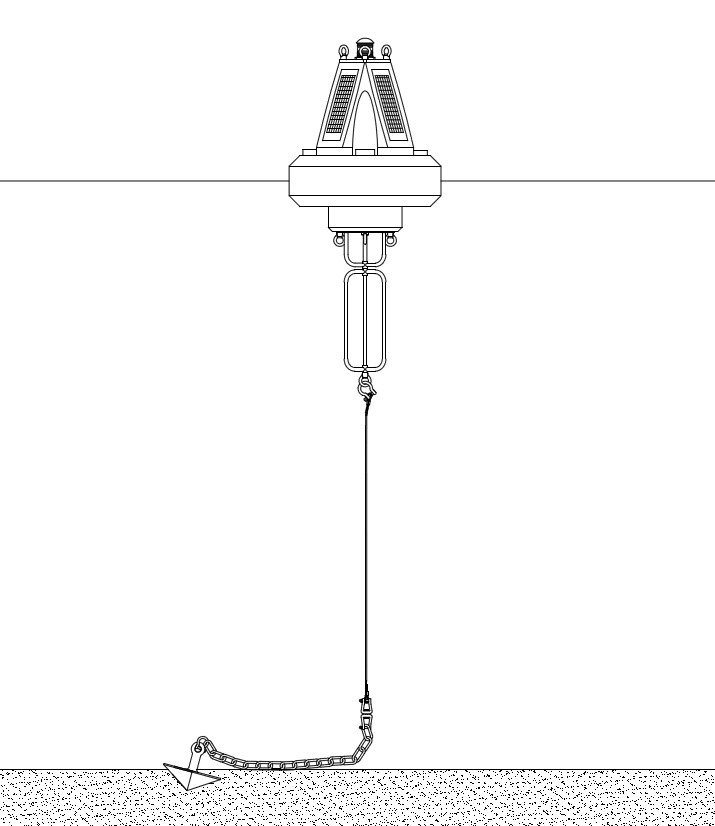
Figure 1: Typical Single-Point Mooring Setup
Two-Point and Three-Point Moorings
Two-point moorings are commonly used when monitoring sensors are deployed in the water column below the buoy. In this setup, the mooring lines are pulled taut away from the buoy, freeing the water column for a suspended sensor line.
In most two-point configurations, mooring lines connect the data buoy to small marine marker floats, often located on the water surface. These marker floats are shackled to another mooring line that runs to the floor and connects to a bottom chain and anchor assembly. Additional subsurface marker floats may also be used in some applications. As in single-point configurations, the bottom chain serves the purpose of preventing buoy submersion as the water level fluctuates.
Three-point configurations are similar to two-point, but a third set of anchors, mooring lines and marker floats are used to anchor the buoy.

Figure 2: Typical Two-Point Mooring Setup
Connecting Mooring Hardware
For NexSens-supplied mooring systems, stainless steel bow shackles are used to connect the various mooring components (mooring lines, marker buoys, chains and anchors) together and to the CB-series buoy. 1/2” bow shackles are used to connect mooring lines to the CB-series buoy eye nuts and to 1/2” bottom chains. Larger, 5/8” bow shackles are required for connection of marker buoys and anchors.
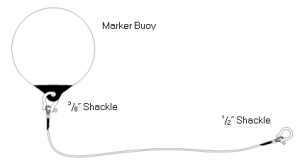
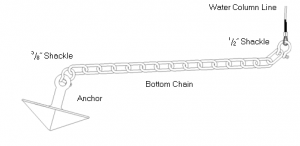
Figure 3: Mooring Components
Bow shackles must be properly connected and secured to prevent loosening, especially in rough water conditions. To attach a mooring line, remove the pin from the shackle and run it through the thimble of the mooring line. Hand-tighten the shackle pin, then use a crescent wrench to tighten the connection. Insert a cable tie into the hole on the shackle pin and run it through the loop of the shackle. Pull tightly to secure, and trim the excess.
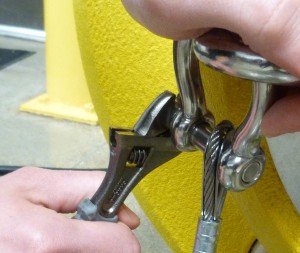
Figure 4: Tighten Bow Shackle
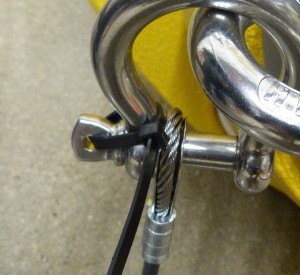
Figure 5: Secure Shackle with Cable Tie
Deployment
Personnel safety is the number one priority when deploying a data buoy. Use of proper equipment (work boat, lifting rig, gloves, safety footwear, etc.) is essential to safely deploy any buoy system. Buoy systems are heavy and personnel can quickly become entangled with mooring lines and anchors. Safety and flotation gear should be worn at all times when working on or near the water.
Remember to perform a complete system test on shore prior to deployment. Learning the nuances of the system is much better handled on shore or in a lab rather than in the field.
Single-Point Mooring Deployment
Deployment of a single-point mooring system is a straightforward process. With the buoy in the boat, begin by connecting all mooring hardware (see above) including the connection of the mooring line to the bottom eye nut of the CB-series buoy.
Next, with the buoy still in the boat, lift the anchor over the side of the boat and drop in the water at the chosen deployment location. Pay out the mooring line so that it does not become entangled. Be sure that the mooring line and bottom chain assembly is long enough that dropping the anchor does not pull the buoy over the side of the boat.
Finalize any sensor connections and apply power, then lift the buoy over the side of the boat and carefully set in the water.
Two-Point and Three-Point Mooring Deployment
For deployment of a two- or three-point mooring system, first connect all mooring components inside the boat. Stage the components so that they can be lifted over the side of the boat and paid out without becoming entangled.
Navigate to the chosen location for the first anchor. The distance from the anchor location to the location of the data buoy is best determined by drawing out a diagram of the mooring system and calculating the horizontal distance, taking into account the lengths of the mooring lines and current water level.
Lift the anchor over the side of the boat and place into the water. Pay out the mooring line as the anchor sinks, using extreme caution to avoid entanglement of the mooring line and especially to avoid entanglement of personnel with the mooring line. Place the marker buoy connected to the line in the water.
Next, move to the desired location of the data buoy. Pay out the mooring line from the first marker buoy to the data buoy as the boat is moved. Finalize sensor connections and apply power, then lift the buoy over the side of the boat and set in the water.
Move onward to the location of the second anchor as the mooring line connecting to the second marker buoy is paid out. Drop the marker buoy in the water and continue to the calculated location for the second anchor. Lift the anchor over the side of the boat and place into the water. Again, pay out the mooring line as the anchor sinks, using extreme caution to avoid entanglement of the mooring line and especially to avoid entanglement of personnel with the mooring line.
Repeat this process if a third mooring point is to be used.
REV: 15B17
